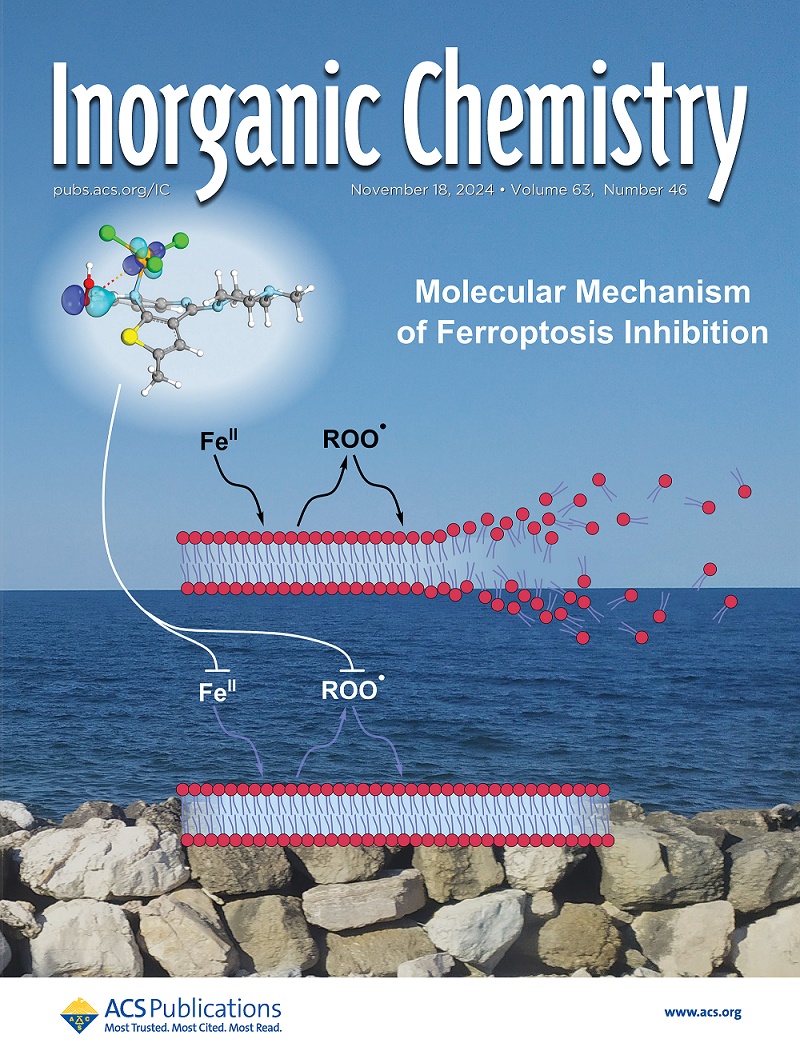状态交叉影响铁(III)水羟基配合物的光解效率。
IF 4.7
2区 化学
Q1 CHEMISTRY, INORGANIC & NUCLEAR
引用次数: 0
摘要
铁(III)-(氢)氧化物和水合铁(III)离子在许多领域都有重要的应用,但它们的配体-金属电荷转移(LMCT)反应由于激发态寿命短或降解而受到较少的关注。本文采用从头算多参考方法研究了铁(III)水羟基配合物的电荷转移光解。我们的研究表明,在铁(III)水合物中,Fe-OH2键的光解和光水解可以同时发生,第二个水合壳作为质子受体促进光水解。在Fe-OH2键的光解过程中,反应性六电子态还会发生系统间的交叉跃迁,转变为低能的非反应性四电子态,这进一步降低了铁(III)水配合物的整体光解效率。在铁(III)-羟基配合物中,铁- oh键的直接光解是主要途径。在二聚铁(III)配合物中,较低的LMCT态会在桥接Fe-OH/Fe-O键的光解过程中发生内部转化以达到基态,从而导致低激发态反应活性。我们的理论结果提高了对铁(III)氢氧配合物的铁氧键光解的理解,并补充了先前对实验观察的解释。这些结果也可能有助于理解水溶液中氧化铁的表面光化学和lmct引发的水氧化。本文章由计算机程序翻译,如有差异,请以英文原文为准。
State Crossing Affects Photolysis Efficiency of Iron(III) Aqua Hydroxo Complexes.
The iron(III)-(hydro)oxides and hydrated iron(III) ion respond to important applications in many fields, but their ligand-to-metal charge-transfer (LMCT) reactions receive less attention due to short excited-state lifetime or degradation. Here, we apply the ab initio multireference method to investigate the charge transfer photolysis of iron(III) aqua hydroxo complexes. Our studies reveal that both Fe-OH2 bond photolysis and photohydrolysis can occur simultaneously in iron(III) aqua complexes, with the second hydration shell promoting photohydrolysis by serving as a proton acceptor. During the photolysis of the Fe-OH2 bond, the reactive sextet electronic states can additionally undergo intersystem crossing transitions to lower-energy, nonreactive quartet states, which further reduces the overall photolytic efficiency of iron(III) aqua complexes. In iron(III)-hydroxy complexes, direct photolysis of the Fe-OH bond is the predominant pathway. In dimeric iron(III) complexes, lower LMCT states would undergo internal conversion to reach the ground state during photolysis of the bridging Fe-OH/Fe-O bond, leading to a low excited-state reactivity. Our theoretical results provide an improved understanding of the iron-oxygen bond photolysis of iron(III) aqua hydroxo complexes and complement previous explanations to experimental observations. These results are also potentially helpful for understanding the surface photochemistry of iron oxides in aqueous solutions and LMCT-triggered water oxidation.
求助全文
通过发布文献求助,成功后即可免费获取论文全文。
去求助
来源期刊

Inorganic Chemistry
化学-无机化学与核化学
CiteScore
7.60
自引率
13.00%
发文量
1960
审稿时长
1.9 months
期刊介绍:
Inorganic Chemistry publishes fundamental studies in all phases of inorganic chemistry. Coverage includes experimental and theoretical reports on quantitative studies of structure and thermodynamics, kinetics, mechanisms of inorganic reactions, bioinorganic chemistry, and relevant aspects of organometallic chemistry, solid-state phenomena, and chemical bonding theory. Emphasis is placed on the synthesis, structure, thermodynamics, reactivity, spectroscopy, and bonding properties of significant new and known compounds.
 求助内容:
求助内容: 应助结果提醒方式:
应助结果提醒方式:


